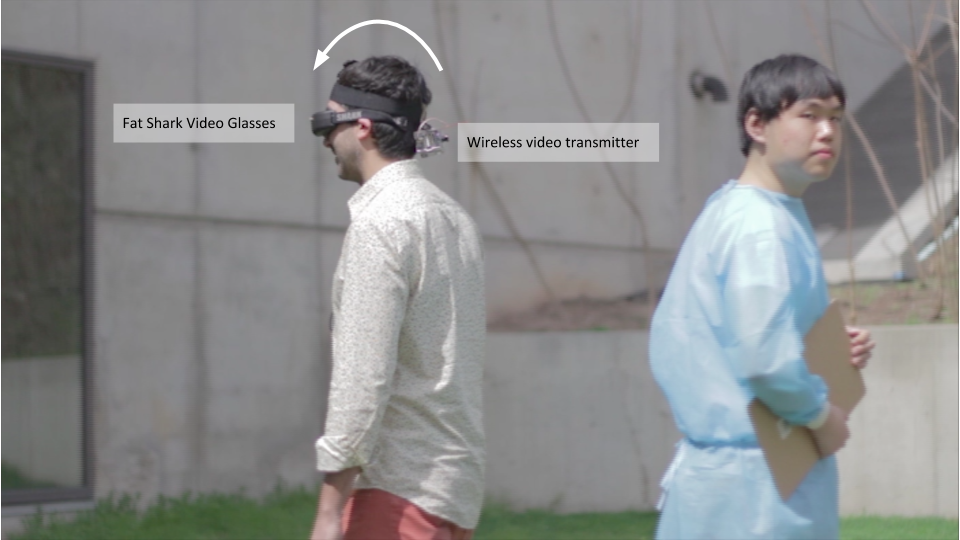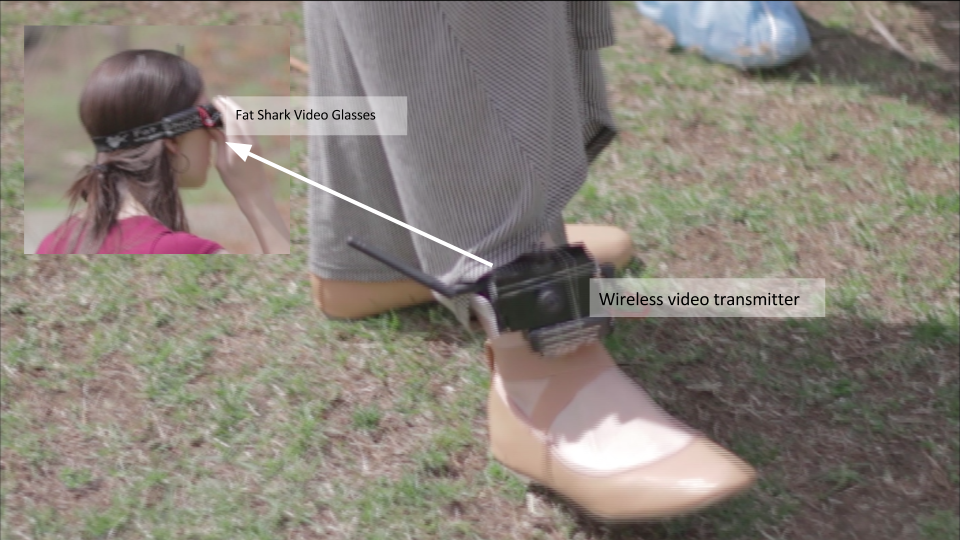Final Project Documentation: “Seeing And Seen”
Identifying oneself and the other through the simultaneous action of both seeing and being seen
Identifying oneself and the other through the simultaneous action of both seeing and being seen
New Clinic for Sensory Vitality, 2014 from Miles Peyton on Vimeo.

The cyclops walking tour, where the patient sees through the back of their head

The Limping Walking Tour, where the patient sees through their ankle
The first New Clinic for Sensory Vitality workshop ran on April 19th. A group of twelve volunteers oversaw the five treatments during the two hours of the event.
This first run of the clinic was not without flaws, many of which were pointed out to me during our class critique. This document outlines a future direction for the project, based on the recommendations that I received and on my own experience running it.
Site
Ideally, a broad demographic would be exposed to the clinic. For this reason, a future iteration of the project would be located at a public site that attracts people of different ages and economic and cultural situations.
Possible sites and/or contexts in Pittsburgh:
– the Point
– buoyant intervention on a river (via The Drift)
– courtyard in front of Giant Eagle
– scenic cemeteries
– an enclosed space like a tent
– VIA festival
Portability
A transient clinic will benefit from the strategies of street musicians. The clinic should be streamlined and portable.
Portability issues to address:
– video glasses and cameras should run on the same type of battery
– the components of each experience should fit in a single crate
– crates will double as table surface
– mode of transportation: bus, van, bikes
Cast
The ages of clinicians impacts the way the clinic is received by the audience. If it is comprised of college-aged actors, then the clinic might be read as a student project. This would undermine its status as a clinic.
A future iteration of NCSV would seek out a more diverse, cross-generational cast. Particularly, the role of elder should not be filled by an 18-19 year old. Here is a post that I put on Craigslist seeking a more appropriate person for this role:
Hello,
I’m a student running a public performance project called the “New Clinic for Sensory Vitality.”
I am looking for someone to fill the role of an elder to interview patients. The elder is a visionary figure who interviews patients about their experience at the clinic, and ideally provides them with guiding advice.
Please contact me if the following describes you:
• 50+ years old
• Comfortable talking to strangers
• Comfortable improvising
If you fit this role, you will perform during the next workshop for about two hours total.
Conversations
Full exchanges between patients and clinicians were not captured on camera, but in my opinion theatricality was one area in which the clinic was lacking. A future iteration of the clinic would approach conversation with more intention and formal rigor.
One technique that artist Tino Sehgal uses to choreograph conversation is prompts, where the first sentence of the conversation is scripted but the rest is improvised. Another lesson from Sehgal is the use of stories to build rapport between strangers. If it is not possible to engage in spontaneous conversation with a patient, the clinician will tell relevant stories, either from previous instances of the clinic or from their past.
Aesthetics
Something that was pointed out to me during the critique was how the clinic was not explicitly medical: it borrowed heavily from the language of corporate branding and new age spirituality. As such, the aesthetics of the clinic need not be explicitly medical. The medical gowns should be replaced by more ambiguous outfits.
Ideas for outfits:
– khaki
– blazers
– official badges
Flow
As some treatments took longer than others, flow became an issue for the clinic. In particular, the Bubble Sound Massage proved to be a bottleneck. Since the Bubble Sound Massage is the treatment that takes the longest, the others treatments will be timed to begin and end with it. One way of doing this is to give a cue when it is time to move to the next treatment. The clinician running the bubble treatment will hit a gong, or make some other signal when they finish.
Revisions to Treatments
Based on the feedback received, minor changes will be made to the treatments. First, having both the Cyclops Walking Tour and the Limping Walking Tour in the same sequence is redundant: the Limping Walking Tour will be removed.
During the event, a clinician ran a treatment for waiting patients. This involved “collecting smells” with syringes. I believe this interim station can be refined. Someone in the critique suggested a scent archive, where different scents are collected and labeled in a grid-like display.
Finally, the procedure for the medical document associated with each patient will be refined. Problematically, the elder did not know what each symbol on the document meant. To solve this, clinicians will stamp the document instead of drawing on it.